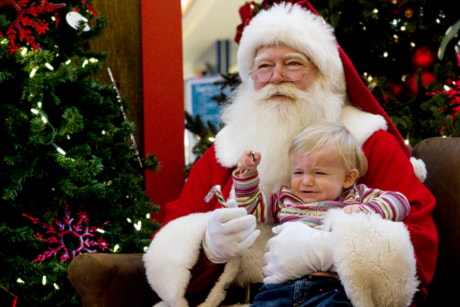TORONTO — Call it a case of Claus-trophobia.
It’s a perennial holiday tradition for children to pose for photos with Santa, and while many relish the chance for face time with the man in red, other little ones may feel shy, nervous, anxious and even teary-eyed when the moment arrives. Christine Tulloch said her daughter Julia, now 2, had seen books and images depicting Santa prior to her first visit with him last year when the jolly elf visited her son’s daycare.
“She would look at a picture and smile and say, ‘Ho, Ho, ho,”’ Tulloch recalled, “but when she saw him in real life, she just panicked.
“We took photos of her on his lap, but she totally flipped out,” she added. “We have a picture of her turning her body away from Santa trying to grab me, like arms outstretched, a look of panic on her face because we tried to put her close to this guy in a red suit.”
During a visit this past summer to Santa’s Village in Bracebridge, Ont., Julia was excited to see Santa but wouldn’t sit on his lap, Tulloch said.
“She’d watch the other kids go and she’d smile, but she didn’t want to go any closer than six feet,” she said, noting, however, that her daughter did sit on Mrs. Claus’s lap and gave her hugs.
Asked for her theory on why Julia seems fearful of Santa in person, Tulloch surmised that it may have something to do with a signature part of St. Nick’s look. “Not many men have beards and certainly not long, bushy ones,” she said. “It might be that you can’t see much of his face under his long hair and hat, so she doesn’t know what to make of him.”
Martin Antony, professor of psychology at Ryerson University in Toronto, said he doesn’t think it’s specifically Santa that’s the issue. For many children, it’s probably any kind of costumed character that may stir feelings of fear or unease, like seeing clowns or having an oversized Mickey Mouse at Disneyworld wanting to shake hands.
Also, some kids are just generally anxious in situations that are out of the ordinary, said Antony, author of The Anti-Anxiety Workbook. “Even though it’s something children would be familiar with from books or television . . . and probably wouldn’t be afraid in that context, when Santa’s right there, it can be scary for kids again because it’s unfamiliar,” he said. “From a distance it may not be too bad, but being picked up and plopped on a stranger’s lap at the best of times may be scary for young children.”
Antony, who is also director of research at the Anxiety Treatment and Research Centre at St. Joseph’s Healthcare in Hamilton, said there are a few things parents can do to help kids prepare to meet Santa.
He suggests helping the child reframe the situation to think about it differently by telling them Santa will be friendly, their parent will be present and that other kids will be around doing the same thing.
Having children watch scenes from movies with other kids sitting on Santa’s lap and even having children observe other kids doing the same in person could be useful, he noted.
Santa can also do his part to help put kids at ease. Jennifer Andrews is owner of the Calgary-based Santa School, which provides professional training to beginner and experienced Santas. They also have “Santa regional representatives” work at events in Calgary and surrounding areas, as well as throughout North America, Europe and Asia.
Participants attend a three-day course to learn all things Santa, from how to emulate his walk and talk and even how to care for their beards.
Andrews said ensuring children are comfortable and have a good experience is of paramount importance.
“If the child is upset about sitting on Santa’s knee, we don’t ever force that,” she said. “If they just want to stand at arm’s length and get a candy cane or just visit with Santa standing on the floor, then that’s how that goes too.”
“But sometimes we’ll encourage the children to have their picture with Santa ... by having them sit on the parent’s lap and the parent standing or sitting on Santa’s knee, and a lot of times children don’t mind that.”
Antony said ultimately the way for individuals to overcome any fear is through exposure and confronting the source of what’s troubling them. A key to a successful exposure experience is for the individual to be in control in the situation.
“If it’s someone afraid of snakes, it would have a very different effect if I were to throw a snake at that person than if I were to encourage the person to approach the snake on their own,” he said. “The one thing that I would recommend to parents is that they would not force children into the situation, but that they would find ways to encourage children to try it and have it be a sort of a fun thing and not making it a negative experience.”
He added, “The absolute worst thing that will happen in a given year is maybe a child won’t be able to do it, and they’ll skip a year of sitting on Santa’s lap.”
